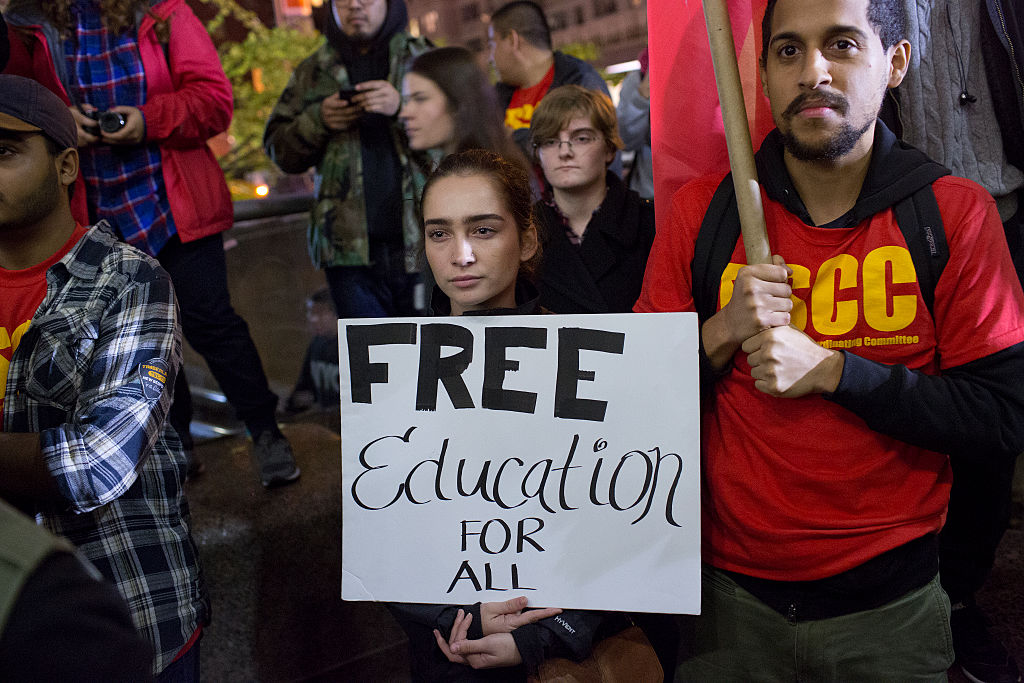Should College Be Free?
 Credit: Image Credit: Andrew Lichtenstein / Corbis News / Getty Images
Credit: Image Credit: Andrew Lichtenstein / Corbis News / Getty Images- The issue of free public higher education enjoys broad bipartisan support.
- Numerous states already offer free community college, but few extend that benefit to four-year public universities.
- The benefits of free college include greater educational access for underserved students, a healthier economy, and reduced loan debt.
- Drawbacks include higher taxes, possible overcrowding, and the threat of quality reduction.
The notion that college should be free seems to be on everyone’s mind.
Former President Joe Biden wanted community colleges to be free. Some lawmakers want four-year public colleges to be free for all but the wealthiest citizens. Bernie Sanders wants public higher education to be free for everyone.
As he enters his second term, will President Donald Trump make good on his pledge to create the “American Academy,” a free online university for all?
To date, more than 30 states have made free community college a reality. A free four-year college education, however, is far less common.

Stay in the Know!
Subscribe to our weekly emails and get the latest college news and resources sent straight to your inbox!
Three years ago, New Mexico introduced its Opportunity Scholarship, which includes tuition waivers at four-year universities, while New York, Indiana, and Washington have similar programs for students who qualify.
A February 2024 poll by the Campaign for Free College Tuition found that 78% of Americans favor free college. College Promise, a similar organization, touts bipartisan support for its agenda.
But is free college actually a good idea? Let’s look at the pros and cons of this controversial issue.
4 Reasons Why College Should Be Free
1. Educational Opportunity Levels Playing Fields
Cost ranks high among the reasons why Americans forego college. Many students simply can’t afford college, or at least believe they can’t. Affordability, or lack thereof, is also the main reason students drop out of college.
This barrier remains especially problematic for low-income, underrepresented minority, and first-generation students, all of whom have comparatively low degree attainment rates.
According to College Promise, a national movement to make college free, only 12% of low-income students earned a four-year degree by age 25 as of 2021, compared to 70% of high-income students.
And Pell Grants haven’t kept pace with college costs. In 1975, Pell Grants covered 79% of college costs; by 2021, that figure had dropped to 30%.
Tuition-free college would go a long way toward closing the achievement gap for low-income and underserved students and reducing racial wealth disparity.
“We believe the best way to increase our nation’s college access and attainment goals and, at the same time, eliminate inequities and achievement gaps across America is to galvanize a nationwide movement in support of making college as universal, accessible, and affordable as high school has been in the U.S. for more than a century,” College Promise wrote in a statement.
2. A More Educated Population Benefits Individuals and the Economy
Free college leads to greater completion rates, which would result in a more educated population.
We know college degrees benefit individuals. Earning a degree can result in as much as a 25% wage increase within a year of graduating. College graduates earn almost twice as much annually as high school graduates. On average, those with a college degree can expect to make $1.2 million more over a lifetime than those without.
We also know widespread degree attainment benefits society as a whole. Because degree-holders earn more, they pay more taxes. They are also less likely to rely on government support such as unemployment benefits, Medicaid, and housing subsidies, to name a few. All told, the Association of Public and Land-Grant Universities estimates each college graduate represents a net gain to society of $381,000 over a lifetime.
What’s more, college graduates are more likely to vote, to volunteer, to make philanthropic contributions, and even to donate blood.
Finally, a more educated citizenry could lead to technological innovations, medical breakthroughs, new industries, and the creation of jobs, bolstering our economy.
In the ongoing debate about whether college is a private or public good, the answer appears to be “both.”
3. Student Loan Debt Will Decrease
In addition to promoting free community college, Biden tried to reduce student loan debt for millions of Americans, an almost $1.6 trillion (down from $1.8 trillion) albatross choking our nation’s economic vitality.
Student loan debt now constitutes more than one-third (34.3%) of non-housing debt, outpacing auto loans and credit cards.
In 2023, Biden took a swing at addressing the problem, but the Supreme Court had a different interpretation of the legality of the former president’s plan.
Meanwhile, college graduates are delaying milestones such as purchasing a home, getting married, and starting a family. In a 2021 poll by the National Association of Realtors, 60% of millennials said student loans were preventing them from buying a house.
Tuition-free college would obviously help reduce that burden. Students might still require loans for living expenses and related costs, but it certainly would amount to less. A 2020 study by the American Enterprise Institute estimated that free college would reduce new borrowing by $177 billion between 2020 and 2030, a reduction of 15% over the otherwise projected amount.
Naturally, this benefit would apply only to students attending public institutions. High costs and steep loan burdens among private college graduates remain serious concerns.
Looking for affordable schools? Read more:
4. Students Can More Freely Pursue Their Passions
In a 2023 BestColleges survey, the top reason students cited for attending college was to “pursue my passion.”
But the pursuit of those passions comes at a cost, and the return on that investment (ROI) doesn’t always justify the means. Surveyed students ranked “creating a better life for myself” second and “improving my income” third among their reasons for attending college.
Majoring in chemical engineering might check all those boxes. Majoring in fine arts probably won’t.
Removing the tuition burden changes the ROI calculus. Sure, it doesn’t mean that religion, education, and psychology majors will earn more in their careers, especially to start, but their debt-to-income ratios will change.
Free of that debt burden, would more students choose majors according to their passions and be less concerned about earning enough to pay back loans? Would more students opt for the liberal arts instead of more “practical” pursuits such as business and engineering?
With more majors in those fields, perhaps universities would be less likely to eviscerate programs and eliminate faculty positions when state budgets tighten. Having a full array of liberal and fine arts courses enriches the curriculum not only for majors but for all students who wish to explore new areas of inquiry.
4 Reasons Why College Should Not Be Free
1. Where Does the Money Come From?
Free college means it’s no cost to students, but it’s not free for the colleges. They still require tuition income, or some form of substitute, to operate. Where do these funds come from?
Biden wanted the government to pay. His budget plan for fiscal year 2025 expanded free community college across the U.S. through a federal-state partnership.
College Promise envisions a similar scenario whereby 75% of funds are provided by the federal government and 25% are matched by participating states. It’s not entirely clear where those funds would come from, but we can assume they would derive from taxes.
Higher taxes means everyone pays for “free” college.
Another option is to underwrite tuition costs through lottery proceeds. For more than 30 years, Georgia has funded its HOPE Scholarship program, which provides scholarship assistance to state residents, through its lottery. But unless a new lottery materializes specifically aimed at raising revenue to cover tuition costs, states would have to divert lottery funds already earmarked for other priorities.
Bernie Sanders wants Wall Street to pay. His “speculation tax” on stock transactions would raise $2.4 trillion over 10 years, making those who “nearly destroyed the economy” during the Great Recession foot the bill for free college and student loan debt cancellation.
Whatever path the federal government and states choose, someone must pay to make college free.
2. Free College Isn’t Entirely Free
Tuition constitutes only part of college costs. Fees, room and board, books, travel, and related expenses can become significant financial burdens, costing more than $16,000 per year on average in 2022. For low-income students, even a “free” college opportunity can be out of reach.
What’s more, current programs based on the “last-dollar” model, which cover tuition after all federal aid is applied, benefit wealthier students more than low-income students, per The Hechinger Report. Pell Grant-eligible students already cover tuition costs at community colleges with those funds, so they don’t actually realize savings like non-Pell students do.
Wil Del Pilar, vice president of higher education policy at the Education Trust, calls free college “a false promise.”
“I don’t think equity is at the heart of these programs,” Del Pilar told The Hechinger Report, “because if it was, they would be designed a bit differently than what we see.”
Another option is the “first-dollar” approach, which waives tuition regardless of federal aid, allowing Pell students to use those funds to cover additional costs. Yet those programs remain the exception to the rule nationwide.
3. Educational Quality Might Suffer
Tuition-free college doesn’t necessarily equate to a better education. In fact, it may diminish quality.
For one, free college promises to boost enrollment, which could lead to overcrowding and require universities to expand infrastructures, add faculty, and bolster student services to accommodate enrollment growth.
But governments have a history of underfunding programs, raising the question of whether federal or state funds would keep pace with enrollment increases and related expenses. If not, the entire academic enterprise could suffer.
Writing in Forbes in 2019, Michael Horn pointed to Germany and England as examples of countries with free college systems whose institutions became “starved.”
“Governments tend to place caps on enrollment and caps on per pupil funding over time — and so the colleges decline in quality,” he wrote.
If state colleges couldn’t expand to accommodate growth, they might instead become far more selective in the face of exploding demand for free education, turning away thousands of applicants. In that case, does free college truly achieve its goal of a more educated populace?
4. Free College Ignores the Root Problem
Colleges don’t necessarily have to be free. But they should be better funded and become more efficient.
According to The Wall Street Journal, public universities “spend like there’s no tomorrow.” The Journal’s analysis revealed that spending at the median flagship state university rose 38% between 2002 and 2022, resulting in a 64% price increase for the average student.
What triggered such spending? Salary increases, along with rising costs for utilities and employee benefits, to be certain, but also swanky dorms and student centers, enviable athletic facilities, and bloated administrations.
“These places are just devouring money,” Holden Thorp, former chancellor at the University of North Carolina at Chapel Hill, told the Journal. “Universities need to focus on what their true priorities are and what they were created to do.”
The Journal also notes public colleges face little accountability for their burgeoning budgets.
At the same time, state funding for higher education continues to decline. The National Education Association points out that 32 states spent less on public colleges in 2020 than in 2008, with an average decrease of almost $1,500 per student.
If states ramped up spending on higher education and universities became more financially responsible and accountable, tuition could remain relatively stable instead of continuing to outpace inflation.
“Today’s free college proposals,” Horn wrote, “merely charge education, in the form of debt for future generations of taxpayers, rather than change it.”